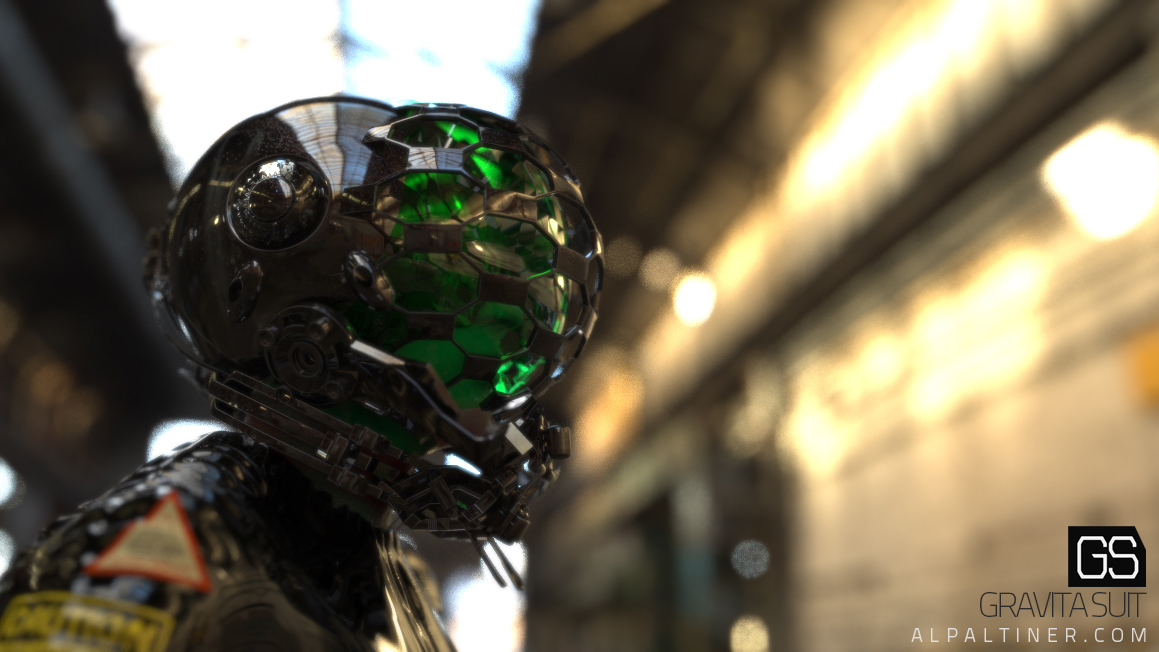 If there’s a person who has taken on just about every form of creative visuals production imaginable, Alp Allen Altiner would be that person. Alp is a Los Angeles based artist, but artist doesn’t begin to explain the amount of experience he has in the production of music, film, gaming, painting, concept and graphic art development across an array of industries that covers media, entertainment and the creative arts. He has over 15 years of learning from the best, creating the best and passing along that knowledge to others. It’s with great pleasure we have the opportunity to talk with Alp, aks him about his career, his workflow and learn how KeyShot has become the main tool in his creative process.
If there’s a person who has taken on just about every form of creative visuals production imaginable, Alp Allen Altiner would be that person. Alp is a Los Angeles based artist, but artist doesn’t begin to explain the amount of experience he has in the production of music, film, gaming, painting, concept and graphic art development across an array of industries that covers media, entertainment and the creative arts. He has over 15 years of learning from the best, creating the best and passing along that knowledge to others. It’s with great pleasure we have the opportunity to talk with Alp, aks him about his career, his workflow and learn how KeyShot has become the main tool in his creative process.
Alp Altiner
Modeling software used: ZBrush / Maya / modo
alpaltiner.com | vfxartportal.com | vfxworkshops.com
 What first sparked your interest in art/cg?
What first sparked your interest in art/cg?
I always knew I wanted to be an artist. Both my parents are artists and I’ve had their tremendous support since I was young from getting how-to-draw books to my dad introducing me to comic books. My inspiration was comic books–the art and stories. I truly fell in love with sequential art and storytelling and, eventually years later, I got into comic books professionally working as an artist over several years for Marvel, DC, Imagine Comics, Top Cow and other publishers. After comics it was motion graphics, then games and then feature film work. The 3D came in when I was working at Digital Domain. Coming from a traditional background, I was truly amazed how much freedom you have with 3D modeling and eventually got into Maya, doing more and more 3D work for feature films. My focus has been digital paintings over the last seven years and while I was building 3D models to paint over, software like KeyShot for material/light rendering and ZBrush for advanced modelling/topology, has allowed me to use more 3D to create my ideas on the digital canvas. Recently I did a speed sculpt of a Batman figure, that still shows my heavy comic book influence and passion for the art form. 3D allows me to move the model into any position with any type of lighting and use it as my drawing reference.
What would you say is unique about your approach to a project?
Using a variety of reference to get the most accurate results for a design or concept. Through careful and selective studies of photography, cinematography, digital painting and 3D, I am able to design photo-realistic concepts that have the convincing visual elements of real life and match how they would be seen through a lens. I think my workflow is what many artists are using today, which is speed sculpting or modeling in 3D, then post work painting over in Photoshop. Back home in Los Angeles, I use to spend a lot more time taking photos and shooting footage on my Canon 5D Mark II. Over the years, I have created a vast library of elements and references that I use on a daily basis in my work. Currently, I spend more time in 3D, and less in post for certain designs, as this gives me the freedom to change my lighting and materials on the fly instead of being locked into a single frame image that takes days to complete and is harder to make changes if the camera position needs updated. 3D is a great addition to the 2D workflow, helping take it a step ahead and removing the limits on the conceptualization of ideas and products.
What is your primary 3d modeling software?
I have used Maya for years, but currently I use a combination of modo and ZBrush; modo and especially ZBrush, I must say. Both programs have very powerful features, but now you are able to do some serious hard surface modelling in ZBrush and features like ZRemesher and DynaMesh put Pixologic ahead of the game. More than ever, it provides you a great opportunity to present your ideas as work in progress speed sculpts to your clients. I have recently started modeling in ZBrush again after many years, and I must say that I don’t think I would use any other program to do my modeling work–you can simply build anything you want. Having invested into modo, I use it occasionally and love their replicators feature, which is great for creating unique designs.
Where in the process do you use KeyShot?
KeyShot is the main tool in my workflow now to achieve photo-realistic results as it is incredibly fast and easy to use. I don’t want to get lost in technical set-up and software that can be very time-consuming to learn. I would rather spend time in the art direction of my ideas, using software and tools to quickly generate convincing results for my clients. After buying KeyShot, I learned how to use it in just a few days and have been using it ever since. Most of my work is about creating convincing cinematic environments, characters, and other related elements. KeyShot speeds up my workflow and I love being able to have the control over the camera, the lens, and additional settings KeyShot offers.
What KeyShot really allows me to do is to take my speed sculpts, or base elements I model for a scene, and view them in a photo-real environment, on the fly, without even waiting to render them directly in the work window. I do less work in Photoshop and more in 3D modeling with materials/lighting and rendering done in KeyShot. There are times where I have used the screenshot feature, since it updates the scene while I work as I drag and drop lights and materials. The default material library makes it very easy to your own custom versions and I’m excited that KeyShot 5 will have a community where we can share these assets. Once I have the lighting, materials and any labels applied to my models, I create alpha channel renders to take into Photoshop for post work. I must say though that, due to the instant realistic results, I hardly have to touch some of my renders, unless I want to apply additional elements as a paint over or lens effects, or perform color corrections. I also love that importing heavy geometry into KeyShot is very easy without affecting my workflow. Wanting to see how far I could push things to create environment renders, I duplicated very dense geometry and change the lighting condition with a simple drag and drop of an HDRI images. I will continue using KeyShot to create photo-realistic 3D Concept Art for Feature Film, Games, Advertising and other related work.
What makes KeyShot an important tool to have?
Quality and time is everything. My job is to create the most realistic results and a variety of concepts in a production environment with tight deadlines. People in other industries may have their reasons for using KeyShot, but I use it for its ease of use, simple interface, drag and drop functions, true physics-based materials, real-time subsurface scattering, physical lights with power control, dynamic texture mapping and control, plus the edit/playback inside a real-time, ray-traced window are just a few things that makes it a MUST HAVE tool for me.
What are some highlights throughout your career?
It was a great opportunity working on so many amazing feature films and game projects over the years. I must say that my very first job working as a Junior Matte Painter/Concept Artist on the film Day After Tomorrow is still one of my favorite projects to this day. I love to study and learn as much as I can, which led to working in so many different fields and creating art for so many different industries. I also really enjoyed working in Advertising/Key Art as an Art Director, designing and creating Movie Posters where I learned most of my Photoshop knowledge and gained the speed I work at today. Regardless of the insane deadlines, coming up with various ideas/designs on the fly and creating comps within hours was an amazing experience and very challenging for me. Designing the wide poster for the movie Gamer was a huge accomplishment for me as an artist. It was a combination of pure design knowledge and photo-realistic matte painting skills. I took a break from movies a couple years ago to work in Video Game Production as an Assistant Art Director and Lead Concept Artist for EA and Eidos. I really enjoyed the work for Army of Two: Devil’s Cartel as the quality of concept art in Gaming today is no different than what would be created in Film. Currently, I am working at MR. X in Toronto as Senior Concept Artist and Matte Painter, continuing my career in the Film industry as a Visual FX Artist.
What advice would you give to someone interested in doing what you do?
As far as working in the Industry as a 2.3D Concept Artist/Matte Painter, I recommend to do as many on-line tutorials as possible and practice on a daily basis. There are so many great online schools today where you can learn any tool in the comfort of your home, as well as many web sites with galleries of work by other professionals. My best advice would be to set goals all the time for yourself, short term and long term. Seek advice from established artists who will give a honest opinion about your work and where you are currently. Maybe even considering an on-line workshop where you can interact with an artist you like. This will give you more insight on how things are done in a production environment so you can prepare yourself, gain knowledge and determine the level you need to be at to get into the field.
What also helps is finding/studying diverse reference material. Along with concept art in movies/games, study an artist’s thinking process and try to discover who your favorite artist studies and where they find inspiration. Study typography, advertising, motion graphics, comic book sequential art, storyboard artists and advance your traditional skills. You will find inspiration from other things, so keep a sketchbook in your car to doodle/sketch everywhere you go. Being able to draw helps me continue the creative process weather I am sculpting in 3D or painting in Photoshop, and the strength in traditional art always guides me, helping me become a better Art Director. After so many years of feature film, games and advertising related works, I still study today like I did ten years ago, because tools advance and there will always be new things to learn and utilize within your workflow. If you are willing to sacrifice your time to learn the tools and make some financial investments towards becoming a VFX Artist, let me tell you, it will pay off in the long run! Strive for becoming the best that you can be as an artist.















